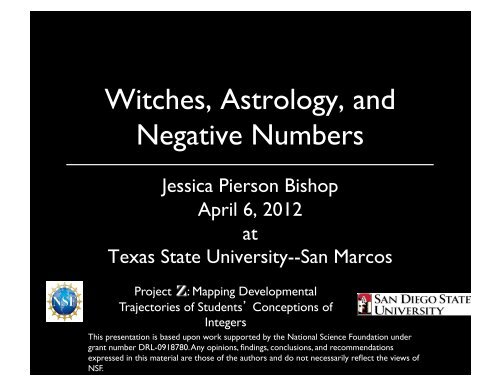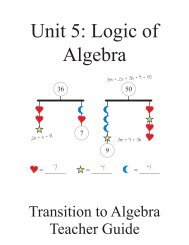Witches Astrology and Negative Numbers
Bishop TSU Witches Astrology & Negatives
Bishop TSU Witches Astrology & Negatives
You also want an ePaper? Increase the reach of your titles
YUMPU automatically turns print PDFs into web optimized ePapers that Google loves.
<strong>Witches</strong>, <strong>Astrology</strong>, <strong>and</strong><br />
<strong>Negative</strong> <strong>Numbers</strong><br />
Jessica Pierson Bishop<br />
April 6, 2012<br />
at<br />
Texas State University--San Marcos<br />
This presentation is based upon work supported by the National Science Foundation under<br />
grant number DRL-0918780. Any opinions, findings, conclusions, <strong>and</strong> recommendations<br />
expressed in this material are those of the authors <strong>and</strong> do not necessarily reflect the views of<br />
NSF.
“Above all, he [the student] must reject the<br />
definition still sometimes given of the<br />
quantity -a, that it is less than nothing. It is<br />
astonishing that the human intellect should<br />
ever have tolerated such an absurdity as the<br />
idea of a quantity less than nothing; above<br />
all, that the notion should have outlived the<br />
belief in judicial astrology <strong>and</strong> the existence<br />
of witches, either of which is ten thous<strong>and</strong><br />
times more possible.” <br />
--Augustus De Morgan, 1898 <br />
On the Study <strong>and</strong> Difficulties of Mathematics, p. 72
Outline of Talk <br />
• Project overview <br />
• <strong>Negative</strong>-number challenges <br />
• Historical perspective <br />
• Ways of Reasoning <br />
• Initial trends across grade b<strong>and</strong>s <br />
• Discussion/questions
Project Goal <br />
• To describe K–12 students<br />
conceptions of integers <strong>and</strong><br />
operations with integers (+<br />
<strong>and</strong> - only) <strong>and</strong> map<br />
possible learning<br />
trajectories.
Why Focus on Students<br />
Mathematical Thinking? <br />
• A large literature base surrounds students<br />
mathematical thinking <strong>and</strong> ways of reasoning (e.g.,<br />
Cognitively Guided Instruction; Karen Fuson <strong>and</strong><br />
colleagues’ work; <strong>and</strong> Purdues Problem-<br />
Centered Mathematics Project). <br />
• Childrens mathematical thinking should inform<br />
instructional decisions when teachers use this<br />
information to productively support <strong>and</strong> extend<br />
childrens reasoning (Black & Wiliam, 1998;<br />
Fennema et al., 1996; Vygotsky, 1998; Wiliam et<br />
al., 2004).
Why Focus on Students<br />
Mathematical Thinking? <br />
• Children often approach problems <strong>and</strong> reason<br />
about them differently than adults do.<br />
• Consider the problem -2 + __ = 4. Solve it in<br />
two ways. <br />
• Liberty is a 2nd grader who had heard of<br />
negative numbers <strong>and</strong> could add <strong>and</strong> subtract<br />
integers using counting strategies. Liberty<br />
answered 7 when solving this problem. How<br />
might she have arrived at that answer?
• Liberty, Grade 2, -2 + = 4
Project Overview <br />
• Developed interview for grades K–12 <strong>and</strong> piloted<br />
more than 90 interviews <br />
• Conducted 160 interviews—cross-sectional design <br />
• 40 from each of Grades 2, 4, 7, <strong>and</strong> 11 across 11<br />
ethnically diverse school sites w/ varying API<br />
scores.<br />
• Problem-solving interviews lasted approximately<br />
1.5 hours <br />
• Open number sentences, compare problems,<br />
story problems (majority of items were open<br />
number) <br />
• Beginning to code <strong>and</strong> analyze data
What we know so far ... <br />
• Young children have ideas about negative numbers<br />
that can be leveraged. <br />
• Different ways of reasoning have both limitations<br />
<strong>and</strong> affordances. <br />
• Underst<strong>and</strong>ing integers is complex! One way of<br />
reasoning is likely insufficient for making sense of<br />
integer operations. <br />
• Similar to mathematicians during the historical<br />
development of integers, students, too, can use<br />
fundamental mathematical principles <strong>and</strong> formalisms<br />
to reason about negative numbers.
Whats so hard about<br />
integers anyway?
The Un-natural<br />
- <br />
Nature of Z <br />
• The existence of quantities less than nothing. <br />
• Removing something from nothing or more<br />
than you have. <br />
• Counterintuitive situations involving routine<br />
interpretations of addition <strong>and</strong> subtraction.
Quantities Less than<br />
Nothing? <br />
• A number tells you, like, how much of<br />
something it is. <strong>Negative</strong> numbers arent<br />
really numbers; they just act like numbers .... I<br />
mean there is no negative 1 cube (Rosie, 2nd<br />
grade).
• <strong>Numbers</strong> that are less than nothing?<br />
Inconceivable! The next thing youll tell me<br />
is that theres a witch outside with my<br />
horoscope (Augustus De Morgan, as<br />
interpreted by Jessica). <br />
• How can you have a negative number of<br />
monkeys? (Bhascara I, 7th century) <br />
• How can you buy a negative amount of cloth<br />
from a merchant? (Chuquet, 1400s)
Taking away more than you<br />
have? <br />
• Andrew, Gr 2,<br />
3 – 5 = __
Something From Nothing? <br />
• Three minus 5 doesnt make sense because 3<br />
is LESS than 5. (Niki, Gr1) <br />
• You may put a mark before 1, which it will<br />
obey: it submits to be taken away from<br />
another number greater than itself, but to<br />
attempt to take it away from the number less<br />
than itself is ridiculous. Yet this is attempted<br />
by algebraists who talk of numbers less than<br />
nothing .... <br />
• --William Frend, The Principles of Algebra,<br />
1796
Something From<br />
Nothing? <br />
• Seth, Gr 1, 3 – 5 = __
Something From<br />
Nothing? <br />
• Seth keeps good company. <br />
“I know people who cannot underst<strong>and</strong><br />
that when you subtract four<br />
from zero, what is left is zero.” <br />
--Blaise Pascal, Pensees,17th century<br />
0 – 4 = 0 ??
Addition Makes Smaller? <br />
• No way! <br />
• Little Diophantus, 2nd grade, 6 + __ = 4
Addition Cannot Make<br />
Smaller <br />
• 4x + 20 = 4 is absurd because the four units<br />
as the result of the summation ought to be<br />
some number greater than 20. (Diophantus,<br />
Grade ?, 3rd century) <br />
• 4 + __ = 3 is not a real problem. Its not<br />
true. (Brad, Gr 1)
Lessons From History <br />
• For these children <strong>and</strong> mathematicians alike,<br />
numbers less than nothing were a paradox.<br />
• Mathematical formalisms helped to broaden<br />
mathematicians ideas about number <strong>and</strong><br />
encouraged the acceptance (finally!) of negative<br />
numbers. Why? <br />
• <strong>Negative</strong> numbers enabled mathematicians to solve<br />
algebraic equations that could not be solved<br />
otherwise.<br />
• The advent of abstract algebra enabled<br />
mathematicians to recognize that various number<br />
domains were possible, that including negatives<br />
afforded nice properties (e.g., inverses), <strong>and</strong> that<br />
different domains could have different properties.
Outline of Talk <br />
• Project overview <br />
• <strong>Negative</strong> number challenges <br />
• Historical perspective <br />
• Ways of Reasoning <br />
• Initial trends across grade b<strong>and</strong>s <br />
• Discussion/questions
Students Integer<br />
Reasoning <br />
<strong>Negative</strong> integers<br />
not in numeric<br />
domain <br />
<strong>Negative</strong> integers<br />
in numeric domain <br />
2nd grade 27 13 <br />
4th grade 13 27 <br />
7th grade 0 40 <br />
11th grade 0 40 <br />
40 120
Students With <strong>Negative</strong> Integers <br />
• Children who have negative integers in their<br />
conceptual domains often approach open<br />
number sentences using one of the following<br />
ways of reasoning: <br />
• Order-based reasoning <br />
• Magnitude-based reasoning <br />
• Computational reasoning <br />
• Limited ways of reasoning <br />
• Formal mathematical approach (e.g., logical<br />
necessity) <br />
• Other/unclear
Students With <strong>Negative</strong> Integers <br />
• Order-based reasoning <br />
• Number line/motion, Grade 7,<br />
-3 + 6 = __
Students With <strong>Negative</strong> Integers <br />
• Order-based reasoning <br />
• Count by ones, Liberty, Grade 2,<br />
-2 + __ = 4
Predictions <br />
• Rosie, a second grader, will use a number line<br />
<strong>and</strong> the idea of motion to try to solve each of<br />
the following problems: <br />
• __ + 5 = 3 <br />
• -5 – 4 = __ <br />
• 5 + __ = 2 <br />
• 3 – __ = -2 <br />
• She correctly solves 3 of the 4. Predict which<br />
one she did not solve correctly.
• Rosie, Grade 2, Motion on a Number Line <br />
• __ + 5 = 3, -5 – 4 = __, & 3 – __ = -2
• Rosie, Grade 2, Motion on a Number Line <br />
• 5 + __ = 2
Next Steps <br />
• Think about Rosie who solved _ + 5 = 3,<br />
3 – __ = -2, <strong>and</strong> -5 – 4 = __ on the number<br />
line but could not solve 5 + ___ = 2 <strong>and</strong><br />
insisted that to evaluate 6 + -2 is impossible<br />
(you did not watch this clip).<br />
• Why did she struggle to solve 5 + __ = 2<br />
<strong>and</strong> 6 + -2? What problem(s) might you<br />
pose next to extend her thinking?
What meaning is<br />
assigned to adding or<br />
subtracting a negative<br />
number?
Whats the<br />
Difference? <br />
• Rosie could not solve<br />
• but could solve<br />
5 + = 2 <br />
+ 5 = 3 <br />
Starting<br />
Point <br />
+ Change = <br />
Ending<br />
Point
Students With <strong>Negative</strong> Integers <br />
• Children who have negative integers in their<br />
conceptual domains often approach open<br />
number sentences using one of the<br />
following ways of reasoning: <br />
• Order-based reasoning <br />
• Magnitude-based reasoning <br />
• Computational reasoning <br />
• Limited ways of reasoning <br />
• Formal mathematical approaches <br />
• Other/unclear
Students With <strong>Negative</strong> Integers <br />
• Magnitude-based reasoning <br />
• <strong>Negative</strong>s like positives, Paulino, Grade 11, -5 + -1
Students With <strong>Negative</strong> Integers <br />
• Magnitude-based reasoning <br />
• <strong>Negative</strong>s like positives, Marlee, Grade 4, -5 – -3 =<br />
__
Students With <strong>Negative</strong> Integers <br />
• Magnitude-based reasoning <br />
• Chips/Inverses, version a, Grade 7, -3 + 6
Students With <strong>Negative</strong> Integers <br />
• Magnitude-based reasoning <br />
• Negs have magnitude (like a chips model) Grade 1,<br />
-8 – -1
Students With <strong>Negative</strong> Integers <br />
• Magnitude-based reasoning <br />
• Metaphor-owing, Grade 4,<br />
-3 + 6
Affordances <strong>and</strong><br />
limitations of a<br />
magnitude-only<br />
approach to negative<br />
numbers
• James, Grade 1, Treats <strong>Negative</strong>s Like<br />
Positives <br />
• -7 – __ = -5
• James, Grade 1, Treats <strong>Negative</strong>s Like<br />
Positives <br />
• 1 + -2 = ___
Next Steps <br />
• Think about James, who solved -5 + -2 <strong>and</strong><br />
-7 – __ = -5 but could not solve 1 + -2 = __<br />
or -1 + 4 = __.<br />
• Why did James struggle with 1 + -2 <strong>and</strong><br />
-1 + 4? What problem(s) might you pose<br />
next to extend his thinking?
<strong>Negative</strong>s & Positives<br />
As Animals in a Zoo <br />
• If negatives are lions <strong>and</strong> positives are<br />
zebras, they must stay in their own cages.<br />
• Of course they dont interact.<br />
• For magnitude-only folks, the main issue<br />
is developing meaning for how to blend<br />
these numbers.
Students With <strong>Negative</strong> Integers <br />
• Children who have negative integers in their<br />
conceptual domains often approach open<br />
number sentences using one of the<br />
following ways of reasoning: <br />
• Order-based reasoning <br />
• Magnitude-based reasoning <br />
• Computational reasoning <br />
• Limited ways of reasoning <br />
• Formal mathematical approaches <br />
• Other/unclear
Students With <strong>Negative</strong> Integers <br />
• Computational-based reasoning <br />
• Keep Change Change (KCC), Gr 11 & 7,<br />
• 6 – -2 = __ & 5 – __ = 8
• Computational approaches arent bad. <br />
• But they can come with trade-offs.<br />
• Although most students could correctly<br />
<strong>and</strong> accurately use rules <strong>and</strong> procedures,<br />
most could not justify them<br />
mathematically.
Students With <strong>Negative</strong> Integers <br />
• Children who have negative integers in their<br />
conceptual domains often approach open<br />
number sentences using one of the<br />
following ways of reasoning: <br />
• Order-based reasoning <br />
• Magnitude-based reasoning <br />
• Computational reasoning <br />
• Limited ways of reasoning <br />
• Formal mathematical approaches <br />
• Other/unclear
Students With <strong>Negative</strong> <strong>Numbers</strong> <br />
• Logical Necessity, Grade 1,<br />
5 + -2 cf. -2 + 5
Students With <strong>Negative</strong> Integers <br />
• Logical Necessity, Grade 11,<br />
6 – -2 cf. 6 – 2
What we know so far ... <br />
• Young children have ideas about negative numbers<br />
that can be leveraged. <br />
• Different ways of reasoning have both limitations<br />
<strong>and</strong> affordances. <br />
• Underst<strong>and</strong>ing integers is complex! One way of<br />
reasoning is likely insufficient for making sense of<br />
integer operations. <br />
• Similar to mathematicians during the historical<br />
development of integers, students, too, can use<br />
fundamental mathematical principles <strong>and</strong> formalisms<br />
to reason about negative numbers.
What have we learned<br />
about integer<br />
reasoning while it<br />
develops over time?
Big Ideas <br />
Prior to Formal Instruction <br />
• Many young children have productive ideas<br />
about negative numbers. <br />
• Children are sense makers <strong>and</strong> often engage in<br />
doing mathematics (Stein et al., 1996). <br />
• Many children are consistent in their<br />
approaches to <strong>and</strong> reasoning about integer<br />
problems. <br />
• In young children we see the emergence of<br />
reasoning about negative numbers in terms of<br />
what we call logical necessity.
Big Ideas <br />
After Formal Instruction <br />
• Most middle school students... <br />
• invoke rules about how to add <strong>and</strong> subtract<br />
negative numbers. <br />
• struggle to explain the rules they invoke. <br />
• Teachers dilemmas include <br />
• how to support student reasoning in concert<br />
with developing efficiency <br />
• how to distinguish “rule following without<br />
underst<strong>and</strong>ing” from reasoned<br />
generalizations
Big Ideas <br />
Long After Formal Instruction,<br />
Successful Mathematics Students <br />
• Most successful high school students invoke a<br />
variety of ways of reasoning to solve problems<br />
involving integer addition <strong>and</strong> subtraction. <br />
• Most high school students struggle to reason about<br />
the equivalence between subtraction <strong>and</strong> adding the<br />
inverse. <br />
• Many successful high school students have not<br />
developed a meaning for – as negation (or the<br />
opposite of).<br />
• Successful high school students have many tools in<br />
their integers belt, yet still have room to grow!
Thank You
Discussion/Questions




